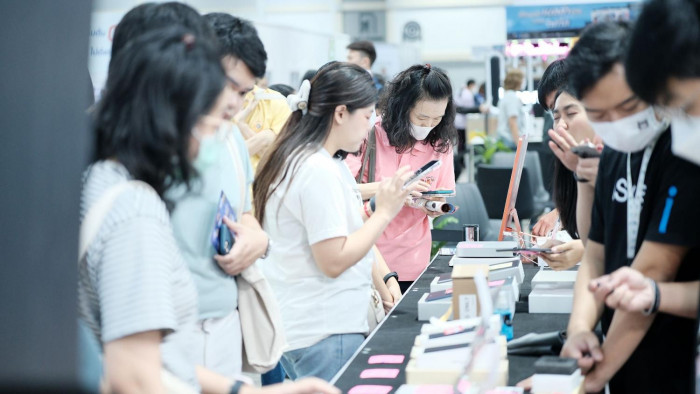The foldable smartphone market in Thailand faces significant hurdles when it comes to mainstream adoption, primarily due to the high prices of the models in the market, a lack of optimised content for foldable displays, and limited consumer demand.
However, foldable mobile devices are of strategic importance in the premium smartphone segment, although they represent a small fraction of overall sales, while Samsung could regain its market share of the segment from Chinese rivals with its newly launched Galaxy Z Fold7 model, according to leading global analyst research firms.
“Samsung has gone thinner and lighter with the Fold7 and Flip7 models, tackling a key criticism of foldables: bulkiness. It’s a major design win, but lasting leadership depends on redefining what foldables do, not just how they look. True differentiation is increasingly driven by what lies beyond physical design,” Sheng Win Chow, a senior analyst at Canalys, part of Omdia, told the Bangkok Post.
The next wave of competition will come from software — how vendors use the foldable form factor to deliver truly differentiated experiences, Mr Chow noted.
Combining multimodal AI with the unique foldable user experience unlocks new possibilities, especially in productivity, multitasking, and language tools, he said.
In 2024, Thailand’s overall smartphone market comprised 16.4 million units, of which foldable devices accounted for 34,542 units, and flip devices with 69,862 units. More than 16.2 million units were the more familiar form of device known as bar phones, according to Canalys.
In terms of shipments of all phones costing more than US$800, defined as the premium category, the smartphone segment still grew in Thailand in 2024, with 2.7 million units sold, up from 2.4 million in 2023.
Shipments of bar phones above $800 increased by 1% to more than 2.6 million units in 2024.
Total shipments of foldable devices dropped to 34,542 units in 2024 from 39,280 units in 2023.
Foldables are still struggling to break into the mainstream. Price remains a major barrier, even among affluent users, as the appeal is not strong enough to drive mass adoption.
Samsung holds more than 70% of the foldable market in Thailand, but its priority now is growing the category by making foldables more appealing to everyday users, rather than just outperforming competitors, Mr Chow added.
Global foldable shipments grew 12% to 17.2 million units in 2024, but Samsung’s share slipped from 54% to 45%.
FLAT GROWTH
Canalys predicts that global foldable shipments will be flat in 2025, due to persistently high prices, a lack of content optimised for foldable displays and muted end-user demand, said Jusy Hong, senior research manager of Canalys.
Francisco Jeronimo, vice-president for EMEA, devices (data & analytics) at IDC, said the global foldable smartphone market grew 4% year-over-year in 2024, reaching 18.7 million units and generating $23.1 billion in value.
While foldable smartphones account for just 1.5% of total smartphone sales, they remain strategically important as vendors use them to target the premium segment. The average sales price of a foldable is $1,234 — nearly triple that of a standard smartphone.
In the overall premium segment of devices priced more than $800, the Apple brand dominates with a 72% share.
But in the ultra-premium segment, pertaining to devices priced over $1,600, Apple’s share drops to 50%, as competitors like Samsung (30%) and Huawei (17%) have established themselves with their innovative foldable products.
Samsung has been the driving force behind the development of foldable smartphones since introducing its first foldable device in 2019.
This first-mover advantage allowed Samsung to dominate the segment with a market share of over 80% that lasted until 2023, when several vendors entered or doubled down in the category, said Mr Jeronimo.
However, Samsung has faced fierce competition. Its share of the foldable market fell from 56% in 2023 to 34% in 2024, as Chinese brands launched thinner, lighter devices that consumers found more attractive.
Despite the innovation from various brands in recent years, adoption of foldable smartphones remains limited, due to high prices, concerns over durability, and limited global availability of some of the most advanced devices from Samsung’s competitors.
The recently launched Samsung foldable models will help Samsung to reignite consumer interest in the foldable segment, particularly with the Galaxy Fold7 model, said Mr Jeronimo.
The substantial improvements in size and weight of foldable devices, along with an even wider display, are a strategic response to a key barrier for many users: carrying a bulky device for the sake of a bigger screen when unfolded.
Kiranjeet Kaur, IDC’s associate research director for mobile phone research, told the Bangkok Post that the share for foldables is less than 1% in Thailand’s smartphone market and it is dominated by Samsung, which had a 77% share last year, although Oppo gained a 41% share in the first quarter of this year.
She added that the premium segment in Thailand has largely been resilient to the economic challenges, and the struggle for the foldable segment is to find a new user base.
